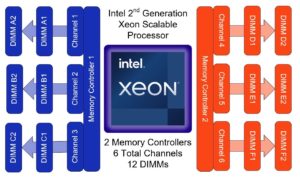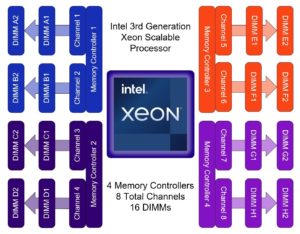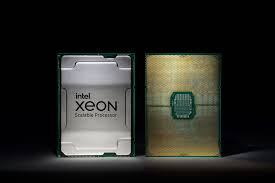How to maximize performance by ensuring memory modules are properly ordered and populated in Intel 3rd Gen Xeon Scalable Processors servers
Memory Architecture of 2nd Gen Intel Xeon Scalable Processor
with two memory controllers that managed three memory channels per controller. Each channel could accept 2 DIMMs in the channel. To calculate the total DIMMs that a processor could support, multiply the number of controllers by the number of channels by the number of DIMMs per channel. For the 2nd Generation Xeon, this equaled a total of 12 DIMMs that a single processor could address.
2nd Gen Intel Xeon Scalable Processors 2 controller 6 channel memory architecture

This memory controller ran at DDR4-2933 speeds with 1 DIMM per channel populated. The speed reduced to DDR4-2666 when populated with 2 DIMMs per channel or Optane Persistent Memory Modules. The optimal configuration for maximizing memory bandwidth populated the same number of identical modules per channel. A two-socket server featured up to 24 DIMMs, allowing for two maximum performance configurations:

It should be noted that servers featuring 16 DIMMs exist for use cases requiring a total of 1TB of memory, but effective memory bandwidth was reduced by 34 percent due to an unbalanced configuration.
Memory Architecture of 3rd Gen Intel Xeon Scalable Processors
Each processor now has four memory controllers with two channels per controller. Each channel can be populated with two DIMMs. A 3rd Gen Xeon can address a total of 16 DIMMs per processor at full performance.
3rd Gen Intel Xeon Scalable Processors 4 controller 8 channel memory architecture

Each of the eight channels runs at DDR4-3200. This is regardless of the number of DIMMs per channel or if 200-series Optane Persistent Memory is populated. Improvements have also been made to the memory scheduler, lowering effective memory latency while increasing the overall bandwidth.
This new design results in a 2.6x increase in overall memory capacity and 1.5x increase in memory compared to 2nd Generation Xeon Scalable, without increasing read latencies at the local or remote socket layer. A two-socket server features up to 32 DIMMs and we still have two balanced memory configurations to choose from for maximum performance:

3rd Generation Xeon Scalable allows for larger capacity memory configurations without sacrificing memory bandwidth. So do some basic considerations should be followed when planning server memory:
- Memory modules must have identical specifications. Each DIMM must have an identical size, speed and rank.
- Channels are identically populated with either one or two DIMMs.
- Each CPU socket in the server must have an identical memory layout.
Scalable processors are available now in DellEMC PowerEdge 15G Servers, HPE ProLiant Gen10 Plus servers and Cisco UCS M6-series servers. We can accommodate virtually any use case or workload.

